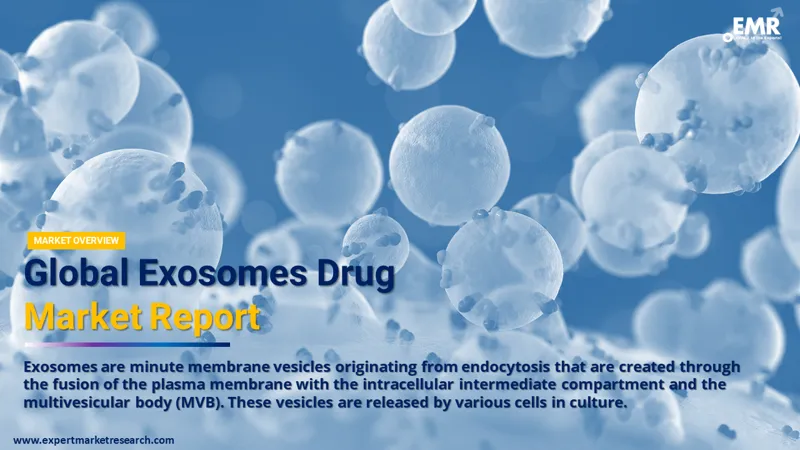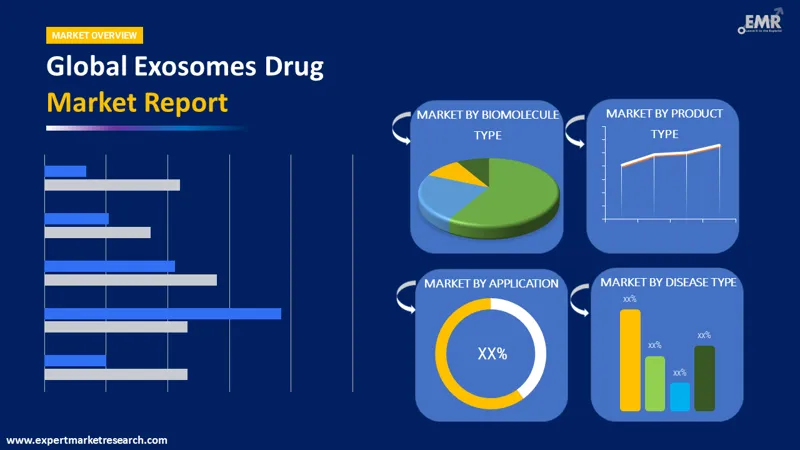
Consumer Insights
Uncover trends and behaviors shaping consumer choices today
Procurement Insights
Optimize your sourcing strategy with key market data
Industry Stats
Stay ahead with the latest trends and market analysis.
The rising cases of cancer have been driving the value of the global exosomes drug market. The number of cancer cases was close to 24.93 Million in 2025. The prevalence of cancer diseases is likely to grow at the rate of 6.60% in the forecast period of 2026-2035. With this growth rate, the number of cases is likely to reach nearly 47.24 Million by 2035.
Base Year
Historical Period
Forecast Period
Compound Annual Growth Rate
6.6%
Value in Million
2026-2035
*this image is indicative*
Exosomes are small membrane vesicles of endocytic origin that are released from various cells in culture and are formed by plasma membrane fusion with the intermediate intracellular compartment and multivesicular body (MVB) fusion.
Exosomes are nano-sized vesicles capable of carrying DNA, small RNA, non-coding RNA, and lipids, with or without direct cell-to-cell communication, representing a new method of cell-to-cell communication.
Exosomes play a vital role in immune responses , viral pathogenicity, pregnancy, cardiovascular disease, central nervous system disease, and cancer progression. Biomolecules, including proteins, metabolites, and nucleic acids, are delivered to target cells by exosomes to adjust biological responses.
Exosomes are designed to deliver variety of therapeutic payloads, including short-interference ribonucleic acids (RNAs), antiallergic oligonucleotides, chemotherapeutic agents, and immunomodulatory agents, and direct their delivery to the desired targets. Liquid biopsy, based on exosome vesicle, can be used to diagnose and determine prognosis in patients with cancer and other diseases. Therefore, the increase in cancer cases in hospitals directly increases the demand for the drugs.

Read more about this report - REQUEST FREE SAMPLE COPY IN PDF
According to the global exosomes drug market research report, the market can be categorised into the following segments:
Market Breakup by Biomolecule Type
Market Breakup by Product Type
Market Breakup by Application
Market Breakup by Disease Type
Market Breakup By Region

Read more about this report - REQUEST FREE SAMPLE COPY IN PDF
The rapid growth of cancer disease drives the growth of the exosomes drug market. The rising demand for advanced drug therapies and potential applications of exosomes in diagnostics are expected to drive the market growth further in the coming years.
The market is primarily driven by the rising cases of cancer, followed by other infectious disease. Advanced exosomes technology in drug development and discovery provides valuable insights into heterogeneity and biological function, enabling us to exploit the therapeutic and diagnostic potential in cancer and infectious diseases. Therefore, the development of medical technology is driving the growth of global exosomes drug market.
The increasing demand for drug therapy in the pharmaceutical and biopharmaceutical fields can be attributed to the potential of exosomes technology as a diagnostic and therapeutic tool used in the treatment of various diseases, such as neurodegeneration, cardiovascular dysfunction, and cancer.
The potential applications of exosomes in cancer diagnostics and the development of precision medicine will increase the use of exosomes in the diagnostic and therapeutic industries, driving the growth of the market.
The rising application of these drugs due to its multifunctional properties has propelled its application in the treatment of various diseases like Alzheimer's disease, chronic heart failure, Parkinson's disease, liver cancer, breast cancer, lung cancer, and prostate cancer.
North America accounted for a significant share of the global market and is expected to grow rapidly during the forecast period. The leading position of the region can be attributed to factors like excellent healthcare infrastructure, effective government policies, large base of multinational corporations, and high public awareness about diagnosis and medical assistance.
On the other hand, the Asia Pacific region is also expected to witness significant growth in the coming years due to the higher presence of the emerging regions and their potential of growth. The regional market is likely to witness further growth due to the competitive strategies that are adopted by players to conduct research and development activities in this sector. Also, the growth of various pharmaceutical companies in this region is another factor that is fuelling the growth of exosomes drug market.
The exosomes drug market has been growing at a rapid rate owing to its multipurpose uses. Exosomes have been a preferred approach for treatment for various disease, including Alzheimer’s disease and COVID-19, among others. Exosomes find extensive clinical applications in the treatment of various diseases as a cell-free alternative for tissue regeneration using therapeutic cargo components, bypassing immune rejection and cytotoxicity.
Stem cell-derived exosomes help harness the anti-inflammatory and regenerative properties of parent cells. Thus, it is possible to design outpatient treatment of respiratory viral diseases, including SARS-CoV-2.
According to a few research studies, exosomes have generated positive results as mediators of intercellular communication, potentially delivering the functional proteins, mRNA transcripts, and miRNAs to cells throughout the body.
Research on exosomes applications is advancing rapidly, but the development of exosome-based therapy, especially the production of exosome formulations, has many difficulties due to low productivity and heterogeneity. Moreover, there are several barriers to the methods of storage, optimisation, and isolation of exosome formulations.
Exosomes are associated with immune responses, viral pathogenesis, pregnancy, cardiovascular disease, diseases related to the central nervous system and the development of cancer. Exosomes do not only aid the diagnosis of diseases but also have therapeutic potential for controlling many diseases.
ExoFlo is a new clinical drug that has not been approved by the Food and Drug Administration. It is a product of extracellular vesicles isolated from human bone marrow stem cells or stromal cells (MSCs). The drug is in phase 2 of clinical development for the treatment of COVID-19, ARDS, and viral pneumonia.
Progenza is developed by Regeneus and is currently in development stage II for osteoarthritis and preclinical stages for neuropathic pain. Progenza is a cellular therapy that targets pain and inflammation, used to improve the tissues where the Secretome is present, and the Mesenchymal Signaling Cells (MSCs) themselves.
The report gives an in-depth analysis of the key players involved in the global exosomes drug market, sponsors manufacturing the drugs, and putting them through trials to get FDA approvals. The companies included in the market are as follows:




*While we strive to always give you current and accurate information, the numbers depicted on the website are indicative and may differ from the actual numbers in the main report. At Expert Market Research, we aim to bring you the latest insights and trends in the market. Using our analyses and forecasts, stakeholders can understand the market dynamics, navigate challenges, and capitalize on opportunities to make data-driven strategic decisions.*
Get in touch with us for a customized solution tailored to your unique requirements and save upto 35%!
The rising prevalence of cancer cases is driving the demand for exosome drugs. The prevalence of cancer cases is likely to grow at the rate of 6.60% during the forecast period of 2026-2035.
The rise in demand for drug therapy in the pharmaceutical and biopharmaceutical field is fuelled by the potential of exosome technology as a diagnostic and therapeutic tool used in the treatment of various diseases, such as neurodegeneration, cardiovascular dysfunction, and cancer.
Based on the product type, the market can be segmented into kits, reagents, and instruments.
Based on the application, the market can be segmented into biomarkers, drug delivery system, vaccine development, therapeutic agents, and others.
Based on the disease type, the market can be fragmented into cancer disease, neurodegenerative disease, cardiovascular disease, infectious disease, tissue regeneration, and others.
The major regions in the industry are North America, Latin America, the Middle East, Africa, Europe, and the Asia Pacific, with North America accounting for the largest share of the market .
North America is expected to dominate the market due to excellent healthcare infrastructure, effective government policies, large base of multinational corporations, and high public awareness about diagnosis and medical assistance.
Danaher Corporation (Beckman Coulter Inc.), Hologic Inc., Lonza Group AG, Fujifilm Holdings Corporation, Miltenyi Biotec GmbH, Qiagen N.V., Thermo Fisher Scientific Inc., JSR Corporation (MBL International), Illumina, Inc., Takara Bio Inc., Malvern Instruments Ltd. (Spectris Plc Company), Abcam Plc., Ampersand Capital Partner (New England Peptide, Inc.), and Evox Therapeutics Ltd. are the top companies in the exosome drug market.
Explore our key highlights of the report and gain a concise overview of key findings, trends, and actionable insights that will empower your strategic decisions.
| REPORT FEATURES | DETAILS |
| Base Year | 2025 |
| Historical Period | 2019-2025 |
| Forecast Period | 2026-2035 |
| Scope of the Report |
Historical and Forecast Trends, Industry Drivers and Constraints, Historical and Forecast Market Analysis by Segment:
|
| Breakup by Biomolecule Type |
|
| Breakup by Product Type |
|
| Breakup by Application |
|
| Breakup by Disease Type |
|
| Breakup By Region |
|
| Market Dynamics |
|
| Supplier Landscape |
|
| Companies Covered |
|
Datasheet
One User
USD 3,299
USD 2,969
tax inclusive*
Single User License
One User
USD 5,499
USD 4,949
tax inclusive*
Five User License
Five User
USD 6,999
USD 5,949
tax inclusive*
Corporate License
Unlimited Users
USD 8,199
USD 6,969
tax inclusive*
*Please note that the prices mentioned below are starting prices for each bundle type. Kindly contact our team for further details.*
Flash Bundle
Small Business Bundle
Growth Bundle
Enterprise Bundle
*Please note that the prices mentioned below are starting prices for each bundle type. Kindly contact our team for further details.*
Flash Bundle
Number of Reports: 3
20%
tax inclusive*
Small Business Bundle
Number of Reports: 5
25%
tax inclusive*
Growth Bundle
Number of Reports: 8
30%
tax inclusive*
Enterprise Bundle
Number of Reports: 10
35%
tax inclusive*
How To Order

Select License Type
Choose the right license for your needs and access rights.

Click on ‘Buy Now’
Add the report to your cart with one click and proceed to register.

Select Mode of Payment
Choose a payment option for a secure checkout. You will be redirected accordingly.
Gain insights to stay ahead and seize opportunities.

Get insights & trends for a competitive edge.

Track prices with detailed trend reports.

Analyse trade data for supply chain insights.

Leverage cost reports for smart savings

Enhance supply chain with partnerships.

Connect For More Information
Our expert team of analysts will offer full support and resolve any queries regarding the report, before and after the purchase.
Our expert team of analysts will offer full support and resolve any queries regarding the report, before and after the purchase.
We employ meticulous research methods, blending advanced analytics and expert insights to deliver accurate, actionable industry intelligence, staying ahead of competitors.
Our skilled analysts offer unparalleled competitive advantage with detailed insights on current and emerging markets, ensuring your strategic edge.
We offer an in-depth yet simplified presentation of industry insights and analysis to meet your specific requirements effectively.
Share